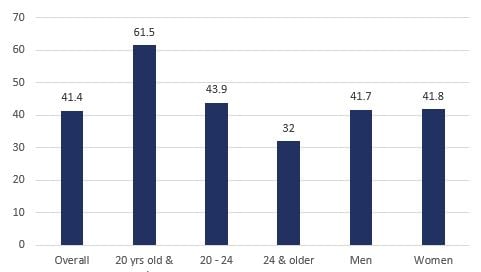Insight
August 31, 2017
Supporting the Two-Year Price Advantage for College Degrees
Previous American Action Forum (AAF) research suggests that students seeking to lower the costs of a higher education should consider tapping into the two-year price advantage. As most public two-year institutions offer robust catalogs of introductory undergraduate courses, students can often meet their general education requirements at a two-year community college before moving on to a four-year institution—and often at a fraction of the cost of taking the same courses at a four-year institution.
A new report from the National Student Loan Clearinghouse provides further evidence to support the two-year option, especially for students 20 years old and younger. Overall, the research found that two in five students earning an associate’s degree go on to obtain a bachelor’s degree within six years. More specifically, it found that the 575,067 associate’s degrees reported to the Clearinghouse for the 2010-11 academic year were earned by students with no previous degrees or certificates; and, within the following six academic years, 65.1 percent of those students went on to enroll at four-year institutions with 41.4 percent earning a bachelor’s degrees. The associate-to-bachelor’s pathway was most frequently completed by students in the 20-and-under age group, with 61.5 percent earning a bachelor’s degree within six years.[1]
Chart 1. Percentage of Students that Earn Bachelor’s Degree After Earning an Associate Degree (2010-11, by age & gender)
Source: National Student Loan Clearinghouse, Research Center
Seeing the benefit of both lowering costs and improving completion rates, seven states are now offering some version of tuition-free college programs. Many of these programs target community college attendance, while New York has committed to free tuition at all its public schools – both two- and four-year institutions. Most of these state programs are designed to offer last-in dollars[2] to cover tuition only, meaning room and board, transportation, meals, and other fees are not included. The table below details the various state programs.
The key takeaway is that students who are prepared and motivated to complete a four-year degree program can greatly benefit from the options offered by two-year community colleges and technical institutions. These programs can be of high quality and may assist in lowering the overall costs of degree completion.
An important caveat is that these programs are designed, offered, and funded by the individual states. In recent years, some federal policymakers have proposed establishing a similar federal grant program. Cost estimates for these programs range from $60 to $80 billion over ten years, and often come with state matching-fund requirements that range from $3.7 billion to $4.1 billion annually. This far exceeds the average amounts currently allocated by the states with existing tuition-free programs. Along with the higher price tags for states, AAF’s review of the proposals found little return on the federal investment for states, students, or federal taxpayers.
Table 1. State Offerings for Tuition-free Programs
| Arkansas | ArFuture Grant |
· Provide two years of tuition and fees at an Arkansas community or technical college to any student who enrolls in a high demand field of study, such as computer science or welding. · Must be a high school graduate with established residency. · There is no grade point average (GPA) prerequisite to receive the grant. · Recipients of the grant may enroll as full-time or part-time students at any in-state community college. · Required to meet monthly with a program mentor · Must complete eight hours of community service per semester. · Following graduation, must work full time in Arkansas for a minimum of three years; otherwise, the grant will be converted to a loan for repayment to the state.
|
| Kentucky | Work Ready Kentucky Scholarship Program |
· Helps Kentuckians who have not yet earned an associate’s degree afford an industry-recognized certificate or diploma. · Must be enrolled at an eligible postsecondary institution in an approved program of study, including health care, advanced manufacturing, transportation/logistics, business services, IT, construction. · Amount equals the maximum amount minus federal and state grants and scholarships. · Maximum amount shall not exceed $4,080 for the 2017‐2018 year. · Provides for 32 credit hours of enrollment. · Must maintain a 2.0 GPA.
|
| Minnesota | MnSCU Two-Year Occupational Grant Pilot Program |
· Provides financial assistance to students enrolled in qualifying career and technical programs at MnSCU two-year colleges. · Created by the 2015 Minnesota Legislature as a pilot program and will be implemented for the 2016-2017 and 2017-2018 academic years. · Must have an adjusted gross income of $90,000 or less for the 2015 tax year. · Grant will cover any remaining tuition and general fee charges after a student’s Federal Pell Grant and MN State Grant have been applied to the account.
· Is available for up to 72 semester credits, including any required developmental courses taken after admission to the occupational program. · Must participate in free mentoring services throughout the pilot program. · Must be enrolled in a qualifying occupational program, which limits participation.
|
| New York | The Excelsior Scholarship |
· Available to New York residents attending CUNY and SUNY wo- and four-year colleges. · For families and individuals making up to $125,000 per year. · Must take 30 credit hours per year. · Must live and work in New York following completion for a time equal to the length of participation in the program. · Up to $5,500, minus amounts received for TAP, Pell or other awards.
|
| Oregon | Oregon Promise |
· Covers most tuition costs at any Oregon community college for recent high school graduates. · For full-time students, awards range from $1,000 to $3,397 per year (in 2016-17), minus a $50 co-pay per term. · Must document a 2.5 cumulative high school GPA or higher, or a GED score of 145 or higher on each test. · Must attend at least half-time at an Oregon community college within 6 months of high school graduation or GED completion.
· Must be an Oregon resident for at least 12 months prior to attendance. · Requires a FAFSA or ORSAA application. · Must not have more than 90 college credits completed or attempted. · Beginning with Fall 2017 applicants, students may be subject to eligibility criteria based on their Expected Family Contribution (EFC)[3].
|
| Rhode Island | Rhode Island Promise |
· All 2017 Rhode Island high school graduates and GED recipients are eligible to pursue a tuition-free associate’s degree at Community College of RI. · Covers last dollars from tuition and fee costs not covered by the Pell grant and other aid. · No income eligibility requirements. · Must earn 30 credits per year. · Must maintain a 2.5 GPA. |
| Tennessee | Tennessee Promise
|
· For Tennessee residents who graduate from an eligible Tennessee high school or home school program or who obtain an equivalency diploma before the age of 19. · Must attend an eligible community or technical two-year college. · Covers last dollars from tuition and fee costs not covered by
the Pell Grant, the HOPE scholarship, Wilder-Naifeh grant or Tennessee Student Assistance Award funds. · Can be used at any of the state’s 13 community colleges, 27 colleges of applied technology or any of the eligible public and private universities with two-year programs. · Mandates students meet with mentors to remain eligible for the program. · Requires eight hours of community service per term enrolled. · Must maintain at least a 2.0 GPA. · Must be enrolled full time in the fall term following high school graduation.
· Launches in fall 2018. · Available to Tennessee adults ages 24 and older. · Provides last-dollar benefits. · Must not have an associate’s or bachelor’s degree. · Must establish Tennessee residency at least one year before applying. · Must be admitted to an eligible institution and be enrolled at least part time. · Must participate in an advising program. · Must maintain continuous enrollment and a 2.0 GPA. |











